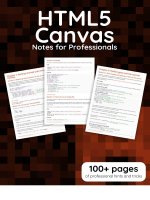TypeScript notes for professionals
Bạn đang xem bản rút gọn của tài liệu. Xem và tải ngay bản đầy đủ của tài liệu tại đây (1.14 MB, 97 trang )
TypeScript
TypeScript
Notes for Professionals
Notes for Professionals
80+ pages
of professional hints and tricks
GoalKicker.com
Free Programming Books
Disclaimer
This is an unocial free book created for educational purposes and is
not aliated with ocial TypeScript group(s) or company(s).
All trademarks and registered trademarks are
the property of their respective owners
Contents
About ................................................................................................................................................................................... 1
Chapter 1: Getting started with TypeScript .................................................................................................... 2
Section 1.1: Installation and setup ................................................................................................................................. 2
Section 1.2: Basic syntax ............................................................................................................................................... 4
Section 1.3: Hello World ................................................................................................................................................. 5
Section 1.4: Running TypeScript using ts-node .......................................................................................................... 6
Section 1.5: TypeScript REPL in Node.js ....................................................................................................................... 6
Chapter 2: Why and when to use TypeScript ................................................................................................. 8
Section 2.1: Safety .......................................................................................................................................................... 8
Section 2.2: Readability ................................................................................................................................................ 8
Section 2.3: Tooling ....................................................................................................................................................... 8
Chapter 3: TypeScript Core Types ....................................................................................................................... 9
Section 3.1: String Literal Types .................................................................................................................................... 9
Section 3.2: Tuple ........................................................................................................................................................ 12
Section 3.3: Boolean .................................................................................................................................................... 12
Section 3.4: Intersection Types .................................................................................................................................. 13
Section 3.5: Types in function arguments and return value. Number ................................................................... 13
Section 3.6: Types in function arguments and return value. String ....................................................................... 14
Section 3.7: const Enum .............................................................................................................................................. 14
Section 3.8: Number .................................................................................................................................................... 15
Section 3.9: String ........................................................................................................................................................ 15
Section 3.10: Array ....................................................................................................................................................... 16
Section 3.11: Enum ........................................................................................................................................................ 16
Section 3.12: Any .......................................................................................................................................................... 16
Section 3.13: Void ......................................................................................................................................................... 16
Chapter 4: Arrays ....................................................................................................................................................... 17
Section 4.1: Finding Object in Array ........................................................................................................................... 17
Chapter 5: Enums ........................................................................................................................................................ 18
Section 5.1: Enums with explicit values ...................................................................................................................... 18
Section 5.2: How to get all enum values ................................................................................................................... 19
Section 5.3: Extending enums without custom enum implementation .................................................................. 19
Section 5.4: Custom enum implementation: extends for enums ............................................................................ 19
Chapter 6: Functions ................................................................................................................................................. 21
Section 6.1: Optional and Default Parameters ......................................................................................................... 21
Section 6.2: Function as a parameter ....................................................................................................................... 21
Section 6.3: Functions with Union Types ................................................................................................................... 23
Section 6.4: Types of Functions ................................................................................................................................. 23
Chapter 7: Classes ...................................................................................................................................................... 24
Section 7.1: Abstract Classes ...................................................................................................................................... 24
Section 7.2: Simple class ............................................................................................................................................. 24
Section 7.3: Basic Inheritance ..................................................................................................................................... 25
Section 7.4: Constructors ............................................................................................................................................ 25
Section 7.5: Accessors ................................................................................................................................................. 26
Section 7.6: Transpilation ........................................................................................................................................... 27
Section 7.7: Monkey patch a function into an existing class .................................................................................. 28
Chapter 8: Class Decorator ................................................................................................................................... 29
Section 8.1: Generating metadata using a class decorator .................................................................................... 29
Section 8.2: Passing arguments to a class decorator ............................................................................................. 29
Section 8.3: Basic class decorator ............................................................................................................................. 30
Chapter 9: Interfaces ................................................................................................................................................ 32
Section 9.1: Extending Interface ................................................................................................................................. 32
Section 9.2: Class Interface ........................................................................................................................................ 32
Section 9.3: Using Interfaces for Polymorphism ...................................................................................................... 33
Section 9.4: Generic Interfaces .................................................................................................................................. 34
Section 9.5: Add functions or properties to an existing interface .......................................................................... 35
Section 9.6: Implicit Implementation And Object Shape ......................................................................................... 35
Section 9.7: Using Interfaces to Enforce Types ....................................................................................................... 36
Chapter 10: Generics ................................................................................................................................................. 37
Section 10.1: Generic Interfaces .................................................................................................................................. 37
Section 10.2: Generic Class ......................................................................................................................................... 37
Section 10.3: Type parameters as constraints ......................................................................................................... 38
Section 10.4: Generics Constraints ............................................................................................................................. 38
Section 10.5: Generic Functions .................................................................................................................................. 39
Section 10.6: Using generic Classes and Functions: ................................................................................................. 39
Chapter 11: Strict null checks ................................................................................................................................ 40
Section 11.1: Strict null checks in action ...................................................................................................................... 40
Section 11.2: Non-null assertions ................................................................................................................................ 40
Chapter 12: User-defined Type Guards ........................................................................................................... 42
Section 12.1: Type guarding functions ....................................................................................................................... 42
Section 12.2: Using instanceof .................................................................................................................................... 43
Section 12.3: Using typeof ........................................................................................................................................... 43
Chapter 13: TypeScript basic examples .......................................................................................................... 45
Section 13.1: 1 basic class inheritance example using extends and super keyword ............................................. 45
Section 13.2: 2 static class variable example - count how many time method is being invoked ....................... 45
Chapter 14: Importing external libraries ........................................................................................................ 46
Section 14.1: Finding definition files ............................................................................................................................ 46
Section 14.2: Importing a module from npm ............................................................................................................ 47
Section 14.3: Using global external libraries without typings .................................................................................. 47
Section 14.4: Finding definition files with TypeScript 2.x .......................................................................................... 47
Chapter 15: Modules - exporting and importing ......................................................................................... 49
Section 15.1: Hello world module ................................................................................................................................ 49
Section 15.2: Re-export ............................................................................................................................................... 49
Section 15.3: Exporting/Importing declarations ....................................................................................................... 51
Chapter 16: Publish TypeScript definition files ............................................................................................ 52
Section 16.1: Include definition file with library on npm ........................................................................................... 52
Chapter 17: Using TypeScript with webpack ................................................................................................ 53
Section 17.1: webpack.config.js ................................................................................................................................... 53
Chapter 18: Mixins ....................................................................................................................................................... 54
Section 18.1: Example of Mixins .................................................................................................................................. 54
Chapter 19: How to use a JavaScript library without a type definition file ................................. 55
Section 19.1: Make a module that exports a default any ......................................................................................... 55
Section 19.2: Declare an any global .......................................................................................................................... 55
Section 19.3: Use an ambient module ....................................................................................................................... 56
Chapter 20: TypeScript installing typescript and running the typescript compiler tsc ........ 57
Section 20.1: Steps ....................................................................................................................................................... 57
Chapter 21: Configure typescript project to compile all files in typescript. ................................ 59
Section 21.1: TypeScript Configuration file setup ..................................................................................................... 59
Chapter 22: Integrating with Build Tools ........................................................................................................ 61
Section 22.1: Browserify .............................................................................................................................................. 61
Section 22.2: Webpack ............................................................................................................................................... 61
Section 22.3: Grunt ...................................................................................................................................................... 62
Section 22.4: Gulp ........................................................................................................................................................ 62
Section 22.5: MSBuild .................................................................................................................................................. 63
Section 22.6: NuGet ..................................................................................................................................................... 63
Section 22.7: Install and configure webpack + loaders ........................................................................................... 64
Chapter 23: Using TypeScript with RequireJS ............................................................................................. 65
Section 23.1: HTML example using RequireJS CDN to include an already compiled TypeScript file ................. 65
Section 23.2: tsconfig.json example to compile to view folder using RequireJS import style ............................ 65
Chapter 24: TypeScript with AngularJS ......................................................................................................... 66
Section 24.1: Directive ................................................................................................................................................. 66
Section 24.2: Simple example .................................................................................................................................... 67
Section 24.3: Component ............................................................................................................................................ 67
Chapter 25: TypeScript with SystemJS ........................................................................................................... 69
Section 25.1: Hello World in the browser with SystemJS ......................................................................................... 69
Chapter 26: Using TypeScript with React (JS & native) ......................................................................... 72
Section 26.1: ReactJS component written in TypeScript ......................................................................................... 72
Section 26.2: TypeScript & react & webpack ........................................................................................................... 73
Chapter 27: TSLint - assuring code quality and consistency ............................................................... 75
Section 27.1: Configuration for fewer programming errors .................................................................................... 75
Section 27.2: Installation and setup ........................................................................................................................... 75
Section 27.3: Sets of TSLint Rules .............................................................................................................................. 76
Section 27.4: Basic tslint.json setup ........................................................................................................................... 76
Section 27.5: Using a predefined ruleset as default ................................................................................................ 76
Chapter 28: tsconfig.json ........................................................................................................................................ 78
Section 28.1: Create TypeScript project with tsconfig.json ..................................................................................... 78
Section 28.2: Configuration for fewer programming errors ................................................................................... 79
Section 28.3: compileOnSave ..................................................................................................................................... 80
Section 28.4: Comments ............................................................................................................................................. 80
Section 28.5: preserveConstEnums ........................................................................................................................... 81
Chapter 29: Debugging ............................................................................................................................................ 82
Section 29.1: TypeScript with ts-node in WebStorm ................................................................................................ 82
Section 29.2: TypeScript with ts-node in Visual Studio Code ................................................................................. 83
Section 29.3: JavaScript with SourceMaps in Visual Studio Code .......................................................................... 84
Section 29.4: JavaScript with SourceMaps in WebStorm ....................................................................................... 84
Chapter 30: Unit Testing ......................................................................................................................................... 86
Section 30.1: tape ......................................................................................................................................................... 86
Section 30.2: jest (ts-jest) ........................................................................................................................................... 87
Section 30.3: Alsatian .................................................................................................................................................. 89
Section 30.4: chai-immutable plugin ......................................................................................................................... 89
Credits .............................................................................................................................................................................. 91
You may also like ........................................................................................................................................................ 93
About
Please feel free to share this PDF with anyone for free,
latest version of this book can be downloaded from:
/>
This TypeScript Notes for Professionals book is compiled from Stack Overflow
Documentation, the content is written by the beautiful people at Stack Overflow.
Text content is released under Creative Commons BY-SA, see credits at the end
of this book whom contributed to the various chapters. Images may be copyright
of their respective owners unless otherwise specified
This is an unofficial free book created for educational purposes and is not
affiliated with official TypeScript group(s) or company(s) nor Stack Overflow. All
trademarks and registered trademarks are the property of their respective
company owners
The information presented in this book is not guaranteed to be correct nor
accurate, use at your own risk
Please send feedback and corrections to
GoalKicker.com – TypeScript Notes for Professionals
1
Chapter 1: Getting started with TypeScript
Version Release Date
2.8.3
2018-04-20
2.8
2018-03-28
2.8 RC
2018-03-16
2.7.2
2018-02-16
2.7.1
2018-02-01
2.7 beta
2018-01-18
2.6.1
2017-11-01
2.5.2
2017-09-01
2.4.1
2017-06-28
2.3.2
2017-04-28
2.3.1
2017-04-25
2.3.0 beta 2017-04-04
2.2.2
2017-03-13
2.2
2017-02-17
2.1.6
2017-02-07
2.2 beta
2017-02-02
2.1.5
2017-01-05
2.1.4
2016-12-05
2.0.8
2016-11-08
2.0.7
2016-11-03
2.0.6
2016-10-23
2.0.5
2016-09-22
2.0 Beta
2016-07-08
1.8.10
2016-04-09
1.8.9
2016-03-16
1.8.5
2016-03-02
1.8.2
2016-02-17
1.7.5
2015-12-14
1.7
2015-11-20
1.6
2015-09-11
1.5.4
2015-07-15
1.5
2015-07-15
1.4
2015-01-13
1.3
2014-10-28
1.1.0.1
2014-09-23
Section 1.1: Installation and setup
Background
TypeScript is a typed superset of JavaScript that compiles directly to JavaScript code. TypeScript files commonly use
the .ts extension. Many IDEs support TypeScript without any other setup required, but TypeScript can also be
compiled with the TypeScript Node.JS package from the command line.
GoalKicker.com – TypeScript Notes for Professionals
2
IDEs
Visual Studio
Visual Studio 2015 includes TypeScript.
Visual Studio 2013 Update 2 or later includes TypeScript, or you can download TypeScript for earlier
versions.
Visual Studio Code
Visual Studio Code (vscode) provides contextual autocomplete as well as refactoring and debugging tools for
TypeScript. vscode is itself implemented in TypeScript. Available for Mac OS X, Windows and Linux.
WebStorm
WebStorm 2016.2 comes with TypeScript and a built-in compiler. [WebStorm is not free]
IntelliJ IDEA
IntelliJ IDEA 2016.2 has support for TypeScript and a compiler via a plugin maintained by the JetBrains
team. [IntelliJ is not free]
Atom & atom-typescript
Atom supports TypeScript with the atom-typescript package.
Sublime Text
Sublime Text supports TypeScript with the TypeScript package.
Installing the command line interface
Install Node.js
Install the npm package globally
You can install TypeScript globally to have access to it from any directory.
npm install -g typescript
or
Install the npm package locally
You can install TypeScript locally and save to package.json to restrict to a directory.
npm install typescript --save-dev Installation channels
You can install from:
Stable channel: npm install typescript
Beta channel: npm install typescript@beta
Dev channel: npm install typescript@next
Compiling TypeScript code
The tsc compilation command comes with typescript, which can be used to compile code.
tsc my-code.ts
This creates a my-code.js file.
Compile using tsconfig.json
GoalKicker.com – TypeScript Notes for Professionals
3
You can also provide compilation options that travel with your code via a tsconfig.json file. To start a new
TypeScript project, cd into your project's root directory in a terminal window and run tsc --init. This command
will generate a tsconfig.json file with minimal configuration options, similar to below.
{
"compilerOptions": {
"module": "commonjs",
"target": "es5",
"noImplicitAny": false,
"sourceMap": false,
"pretty": true
},
"exclude": [
"node_modules"
]
}
With a tsconfig.json file placed at the root of your TypeScript project, you can use the tsc command to run the
compilation.
Section 1.2: Basic syntax
TypeScript is a typed superset of JavaScript, which means that all JavaScript code is valid TypeScript code. TypeScript
adds a lot of new features on top of that.
TypeScript makes JavaScript more like a strongly-typed, object-oriented language akin to C# and Java. This means
that TypeScript code tends to be easier to use for large projects and that code tends to be easier to understand and
maintain. The strong typing also means that the language can (and is) precompiled and that variables cannot be
assigned values that are out of their declared range. For instance, when a TypeScript variable is declared as a
number, you cannot assign a text value to it.
This strong typing and object orientation makes TypeScript easier to debug and maintain, and those were two of
the weakest points of standard JavaScript.
Type declarations
You can add type declarations to variables, function parameters and function return types. The type is written after
a colon following the variable name, like this: var num: number = 5; The compiler will then check the types (where
possible) during compilation and report type errors.
var num: number = 5;
num = "this is a string";
// error: Type 'string' is not assignable to type 'number'.
The basic types are :
number (both integers and floating point numbers)
string
boolean
Array. You can specify the types of an array's elements. There are two equivalent ways to define array types:
Array<T> and T[]. For example:
number[] - array of numbers
Array<string> - array of strings
Tuples. Tuples have a fixed number of elements with specific types.
[boolean, string] - tuple where the first element is a boolean and the second is a string.
[number, number, number] - tuple of three numbers.
GoalKicker.com – TypeScript Notes for Professionals
4
{} - object, you can define its properties or indexer
{name: string, age: number} - object with name and age attributes
{[key: string]: number} - a dictionary of numbers indexed by string
enum - { Red = 0, Blue, Green } - enumeration mapped to numbers
Function. You specify types for the parameters and return value:
(param: number) => string - function taking one number parameter returning string
() => number - function with no parameters returning an number.
(a: string, b?: boolean) => void - function taking a string and optionally a boolean with no return
value.
any - Permits any type. Expressions involving any are not type checked.
void - represents "nothing", can be used as a function return value. Only null and undefined are part of the
void type.
never
let foo: never; -As the type of variables under type guards that are never true.
function error(message: string): never { throw new Error(message); } - As the return type of
functions that never return.
null - type for the value null. null is implicitly part of every type, unless strict null checks are enabled.
Casting
You can perform explicit casting through angle brackets, for instance:
var derived: MyInterface;
(<ImplementingClass>derived).someSpecificMethod();
This example shows a derived class which is treated by the compiler as a MyInterface. Without the casting on the
second line the compiler would throw an exception as it does not understand someSpecificMethod(), but casting
through <ImplementingClass>derived suggests the compiler what to do.
Another way of casting in TypeScript is using the as keyword:
var derived: MyInterface;
(derived as ImplementingClass).someSpecificMethod();
Since TypeScript 1.6, the default is using the as keyword, because using <> is ambiguous in .jsx files. This is
mentioned in TypeScript official documentation.
Classes
Classes can be defined and used in TypeScript code. To learn more about classes, see the Classes documentation
page.
Section 1.3: Hello World
class Greeter {
greeting: string;
constructor(message: string) {
this.greeting = message;
}
greet(): string {
return this.greeting;
}
};
GoalKicker.com – TypeScript Notes for Professionals
5
let greeter = new Greeter("Hello, world!");
console.log(greeter.greet());
Here we have a class, Greeter, that has a constructor and a greet method. We can construct an instance of the
class using the new keyword and pass in a string we want the greet method to output to the console. The instance
of our Greeter class is stored in the greeter variable which we then us to call the greet method.
Section 1.4: Running TypeScript using ts-node
ts-node is an npm package which allows the user to run typescript files directly, without the need for
precompilation using tsc. It also provides REPL.
Install ts-node globally using
npm install -g ts-node
ts-node does not bundle typescript compiler, so you might need to install it.
npm install -g typescript
Executing script
To execute a script named main.ts, run
ts-node main.ts
// main.ts
console.log("Hello world");
Example usage
$ ts-node main.ts
Hello world
Running REPL
To run REPL run command ts-node
Example usage
$ ts-node
> const sum = (a, b): number => a + b;
undefined
> sum(2, 2)
4
> .exit
To exit REPL use command .exit or press CTRL+C twice.
Section 1.5: TypeScript REPL in Node.js
For use TypeScript REPL in Node.js you can use tsun package
Install it globally with
GoalKicker.com – TypeScript Notes for Professionals
6
npm install -g tsun
and run in your terminal or command prompt with tsun command
Usage example:
$ tsun
TSUN : TypeScript Upgraded Node
type in TypeScript expression to evaluate
type :help for commands in repl
$ function multiply(x, y) {
..return x * y;
..}
undefined
$ multiply(3, 4)
12
GoalKicker.com – TypeScript Notes for Professionals
7
Chapter 2: Why and when to use
TypeScript
If you find the arguments for type systems persuasive in general, then you'll be happy with TypeScript.
It brings many of the advantages of type system (safety, readability, improved tooling) to the JavaScript ecosystem.
It also suffers from some of the drawbacks of type systems (added complexity and incompleteness).
Section 2.1: Safety
TypeScript catches type errors early through static analysis:
function double(x: number): number {
return 2 * x;
}
double('2');
//
~~~ Argument of type '"2"' is not assignable to parameter of type 'number'.
Section 2.2: Readability
TypeScript enables editors to provide contextual documentation:
You'll never forget whether String.prototype.slice takes (start, stop) or (start, length) again!
Section 2.3: Tooling
TypeScript allows editors to perform automated refactors which are aware of the rules of the languages.
Here, for instance, Visual Studio Code is able to rename references to the inner foo without altering the outer foo.
This would be difficult to do with a simple find/replace.
GoalKicker.com – TypeScript Notes for Professionals
8
Chapter 3: TypeScript Core Types
Section 3.1: String Literal Types
String literal types allow you to specify the exact value a string can have.
let myFavoritePet: "dog";
myFavoritePet = "dog";
Any other string will give an error.
// Error: Type '"rock"' is not assignable to type '"dog"'.
// myFavoritePet = "rock";
Together with Type Aliases and Union Types you get a enum-like behavior.
type Species = "cat" | "dog" | "bird";
function buyPet(pet: Species, name: string) : Pet { /*...*/ }
buyPet(myFavoritePet /* "dog" as defined above */, "Rocky");
// Error: Argument of type '"rock"' is not assignable to parameter of type "'cat' | "dog" | "bird".
Type '"rock"' is not assignable to type '"bird"'.
// buyPet("rock", "Rocky");
String Literal Types can be used to distinguish overloads.
function
function
function
function
function
buyPet(pet:
buyPet(pet:
buyPet(pet:
buyPet(pet:
buyPet(pet:
Species, name: string) : Pet;
"cat", name: string): Cat;
"dog", name: string): Dog;
"bird", name: string): Bird;
Species, name: string) : Pet { /*...*/ }
let dog = buyPet(myFavoritePet /* "dog" as defined above */, "Rocky");
// dog is from type Dog (dog: Dog)
They works well for User-Defined Type Guards.
interface Pet {
species: Species;
eat();
sleep();
}
interface Cat extends Pet {
species: "cat";
}
interface Bird extends Pet {
species: "bird";
sing();
}
function petIsCat(pet: Pet): pet is Cat {
return pet.species === "cat";
}
GoalKicker.com – TypeScript Notes for Professionals
9
function petIsBird(pet: Pet): pet is Bird {
return pet.species === "bird";
}
function playWithPet(pet: Pet){
if(petIsCat(pet)) {
// pet is now from type Cat (pet: Cat)
pet.eat();
pet.sleep();
} else if(petIsBird(pet)) {
// pet is now from type Bird (pet: Bird)
pet.eat();
pet.sing();
pet.sleep();
}
}
Full example code
let myFavoritePet: "dog";
myFavoritePet = "dog";
// Error: Type '"rock"' is not assignable to type '"dog"'.
// myFavoritePet = "rock";
type Species = "cat" | "dog" | "bird";
interface Pet {
species: Species;
name: string;
eat();
walk();
sleep();
}
interface Cat extends Pet {
species: "cat";
}
interface Dog extends Pet {
species: "dog";
}
interface Bird extends Pet {
species: "bird";
sing();
}
// Error: Interface 'Rock' incorrectly extends interface 'Pet'. Types of property 'species' are
incompatible. Type '"rock"' is not assignable to type '"cat" | "dog" | "bird"'. Type '"rock"' is not
assignable to type '"bird"'.
// interface Rock extends Pet {
//
type: "rock";
// }
function buyPet(pet: Species, name: string) : Pet;
function buyPet(pet: "cat", name: string): Cat;
function buyPet(pet: "dog", name: string): Dog;
function buyPet(pet: "bird", name: string): Bird;
function buyPet(pet: Species, name: string) : Pet {
if(pet === "cat") {
GoalKicker.com – TypeScript Notes for Professionals
10
return {
species: "cat",
name: name,
eat: function () {
console.log(`${this.name} eats.`);
}, walk: function () {
console.log(`${this.name} walks.`);
}, sleep: function () {
console.log(`${this.name} sleeps.`);
}
} as Cat;
} else if(pet === "dog") {
return {
species: "dog",
name: name,
eat: function () {
console.log(`${this.name} eats.`);
}, walk: function () {
console.log(`${this.name} walks.`);
}, sleep: function () {
console.log(`${this.name} sleeps.`);
}
} as Dog;
} else if(pet === "bird") {
return {
species: "bird",
name: name,
eat: function () {
console.log(`${this.name} eats.`);
}, walk: function () {
console.log(`${this.name} walks.`);
}, sleep: function () {
console.log(`${this.name} sleeps.`);
}, sing: function () {
console.log(`${this.name} sings.`);
}
} as Bird;
} else {
throw `Sorry we do not have a ${pet}. Would you like to buy a dog?`;
}
}
function petIsCat(pet: Pet): pet is Cat {
return pet.species === "cat";
}
function petIsDog(pet: Pet): pet is Dog {
return pet.species === "dog";
}
function petIsBird(pet: Pet): pet is Bird {
return pet.species === "bird";
}
function playWithPet(pet: Pet) {
console.log(`Hey ${pet.name}, lets play.`);
if(petIsCat(pet)) {
// pet is now from type Cat (pet: Cat)
pet.eat();
pet.sleep();
GoalKicker.com – TypeScript Notes for Professionals
11
// Error: Type '"bird"' is not assignable to type '"cat"'.
// pet.type = "bird";
// Error: Property 'sing' does not exist on type 'Cat'.
// pet.sing();
} else if(petIsDog(pet)) {
// pet is now from type Dog (pet: Dog)
pet.eat();
pet.walk();
pet.sleep();
} else if(petIsBird(pet)) {
// pet is now from type Bird (pet: Bird)
pet.eat();
pet.sing();
pet.sleep();
} else {
throw "An unknown pet. Did you buy a rock?";
}
}
let dog = buyPet(myFavoritePet /* "dog" as defined above */, "Rocky");
// dog is from type Dog (dog: Dog)
// Error: Argument of type '"rock"' is not assignable to parameter of type "'cat' | "dog" | "bird".
Type '"rock"' is not assignable to type '"bird"'.
// buyPet("rock", "Rocky");
playWithPet(dog);
// Output: Hey Rocky, lets play.
//
Rocky eats.
//
Rocky walks.
//
Rocky sleeps.
Section 3.2: Tuple
Array type with known and possibly different types:
let day: [number, string];
day = [0, 'Monday'];
// valid
day = ['zero', 'Monday']; // invalid: 'zero' is not numeric
console.log(day[0]); // 0
console.log(day[1]); // Monday
day[2] = 'Saturday'; // valid: [0, 'Saturday']
day[3] = false;
// invalid: must be union type of 'number | string'
Section 3.3: Boolean
A boolean represents the most basic datatype in TypeScript, with the purpose of assigning true/false values.
// set with initial value (either true or false)
let isTrue: boolean = true;
// defaults to 'undefined', when not explicitly set
let unsetBool: boolean;
GoalKicker.com – TypeScript Notes for Professionals
12
// can also be set to 'null' as well
let nullableBool: boolean = null;
Section 3.4: Intersection Types
A Intersection Type combines the member of two or more types.
interface Knife {
cut();
}
interface BottleOpener{
openBottle();
}
interface Screwdriver{
turnScrew();
}
type SwissArmyKnife = Knife & BottleOpener & Screwdriver;
function use(tool: SwissArmyKnife){
console.log("I can do anything!");
tool.cut();
tool.openBottle();
tool.turnScrew();
}
Section 3.5: Types in function arguments and return value.
Number
When you create a function in TypeScript you can specify the data type of the function's arguments and the data
type for the return value
Example:
function sum(x: number, y: number): number {
return x + y;
}
Here the syntax x: number, y: number means that the function can accept two argumentsx and y and they can
only be numbers and (...): number { means that the return value can only be a number
Usage:
sum(84 + 76) // will be return 160
Note:
You can not do so
function sum(x: string, y: string): number {
return x + y;
}
or
GoalKicker.com – TypeScript Notes for Professionals
13
function sum(x: number, y: number): string {
return x + y;
}
it will receive the following errors:
error TS2322: Type 'string' is not assignable to type 'number' and error TS2322: Type 'number' is
not assignable to type 'string' respectively
Section 3.6: Types in function arguments and return value.
String
Example:
function hello(name: string): string {
return `Hello ${name}!`;
}
Here the syntax name: string means that the function can accept one name argument and this argument can only
be string and (...): string { means that the return value can only be a string
Usage:
hello('StackOverflow Documentation') // will be return Hello StackOverflow Documentation!
Section 3.7: const Enum
A const Enum is the same as a normal Enum. Except that no Object is generated at compile time. Instead, the literal
values are substituted where the const Enum is used.
// TypeScript: A const Enum can be defined like a normal Enum (with start value, specific values,
etc.)
const enum NinjaActivity {
Espionage,
Sabotage,
Assassination
}
// JavaScript: But nothing is generated
// TypeScript: Except if you use it
let myFavoriteNinjaActivity = NinjaActivity.Espionage;
console.log(myFavoritePirateActivity); // 0
// JavaScript: Then only the number of the value is compiled into the code
// var myFavoriteNinjaActivity = 0 /* Espionage */;
// console.log(myFavoritePirateActivity); // 0
// TypeScript: The same for the other constant example
console.log(NinjaActivity["Sabotage"]); // 1
// JavaScript: Just the number and in a comment the name of the value
// console.log(1 /* "Sabotage" */); // 1
// TypeScript: But without the object none runtime access is possible
// Error: A const enum member can only be accessed using a string literal.
// console.log(NinjaActivity[myFavoriteNinjaActivity]);
GoalKicker.com – TypeScript Notes for Professionals
14
For comparison, a normal Enum
// TypeScript: A normal Enum
enum PirateActivity {
Boarding,
Drinking,
Fencing
}
//
//
//
//
//
//
//
JavaScript: The Enum after the compiling
var PirateActivity;
(function (PirateActivity) {
PirateActivity[PirateActivity["Boarding"] = 0] = "Boarding";
PirateActivity[PirateActivity["Drinking"] = 1] = "Drinking";
PirateActivity[PirateActivity["Fencing"] = 2] = "Fencing";
})(PirateActivity || (PirateActivity = {}));
// TypeScript: A normal use of this Enum
let myFavoritePirateActivity = PirateActivity.Boarding;
console.log(myFavoritePirateActivity); // 0
// JavaScript: Looks quite similar in JavaScript
// var myFavoritePirateActivity = PirateActivity.Boarding;
// console.log(myFavoritePirateActivity); // 0
// TypeScript: And some other normal use
console.log(PirateActivity["Drinking"]); // 1
// JavaScript: Looks quite similar in JavaScript
// console.log(PirateActivity["Drinking"]); // 1
// TypeScript: At runtime, you can access an normal enum
console.log(PirateActivity[myFavoritePirateActivity]); // "Boarding"
// JavaScript: And it will be resolved at runtime
// console.log(PirateActivity[myFavoritePirateActivity]); // "Boarding"
Section 3.8: Number
Like JavaScript, numbers are floating point values.
let pi: number = 3.14;
let hexadecimal: number = 0xFF;
// base 10 decimal by default
// 255 in decimal
ECMAScript 2015 allows binary and octal.
let binary: number = 0b10;
let octal: number = 0o755;
// 2 in decimal
// 493 in decimal
Section 3.9: String
Textual data type:
let singleQuotes: string = 'single';
let doubleQuotes: string = "double";
let templateString: string = `I am ${ singleQuotes }`; // I am single
GoalKicker.com – TypeScript Notes for Professionals
15
Section 3.10: Array
An array of values:
let threePigs: number[] = [1, 2, 3];
let genericStringArray: Array<string> = ['first', '2nd', '3rd'];
Section 3.11: Enum
A type to name a set of numeric values:
Number values default to 0:
enum Day { Monday, Tuesday, Wednesday, Thursday, Friday, Saturday, Sunday };
let bestDay: Day = Day.Saturday;
Set a default starting number:
enum TenPlus { Ten = 10, Eleven, Twelve }
or assign values:
enum MyOddSet { Three = 3, Five = 5, Seven = 7, Nine = 9 }
Section 3.12: Any
When unsure of a type, any is available:
let anything: any = 'I am a string';
anything = 5; // but now I am the number 5
Section 3.13: Void
If you have no type at all, commonly used for functions that do not return anything:
function log(): void {
console.log('I return nothing');
}
void types Can only be assigned null or undefined.
GoalKicker.com – TypeScript Notes for Professionals
16
Chapter 4: Arrays
Section 4.1: Finding Object in Array
Using find()
const inventory = [
{name: 'apples', quantity: 2},
{name: 'bananas', quantity: 0},
{name: 'cherries', quantity: 5}
];
function findCherries(fruit) {
return fruit.name === 'cherries';
}
inventory.find(findCherries); // { name: 'cherries', quantity: 5 }
/* OR */
inventory.find(e => e.name === 'apples'); // { name: 'apples', quantity: 2 }
GoalKicker.com – TypeScript Notes for Professionals
17
Chapter 5: Enums
Section 5.1: Enums with explicit values
By default all enum values are resolved to numbers. Let's say if you have something like
enum MimeType {
JPEG,
PNG,
}
the real value behind e.g. MimeType.PDF will be 2.
But some of the time it is important to have the enum resolve to a different type. E.g. you receive the value from
backend / frontend / another system which is definitely a string. This could be a pain, but luckily there is this
method:
enum MimeType {
JPEG = <any>'image/jpeg',
PNG = <any>'image/png',
PDF = <any>'application/pdf'
}
This resolves the MimeType.PDF to application/pdf.
Since TypeScript 2.4 it's possible to declare string enums:
enum MimeType {
JPEG = 'image/jpeg',
PNG = 'image/png',
PDF = 'application/pdf',
}
You can explicitly provide numeric values using the same method
enum MyType {
Value = 3,
ValueEx = 30,
ValueEx2 = 300
}
Fancier types also work, since non-const enums are real objects at runtime, for example
enum FancyType {
OneArr = <any>[1],
TwoArr = <any>[2, 2],
ThreeArr = <any>[3, 3, 3]
}
becomes
var FancyType;
(function (FancyType) {
FancyType[FancyType["OneArr"] = [1]] = "OneArr";
FancyType[FancyType["TwoArr"] = [2, 2]] = "TwoArr";
GoalKicker.com – TypeScript Notes for Professionals
18
FancyType[FancyType["ThreeArr"] = [3, 3, 3]] = "ThreeArr";
})(FancyType || (FancyType = {}));
Section 5.2: How to get all enum values
enum SomeEnum { A, B }
let enumValues:Array<string>= [];
for(let value in SomeEnum) {
if(typeof SomeEnum[value] === 'number') {
enumValues.push(value);
}
}
enumValues.forEach(v=> console.log(v))
//A
//B
Section 5.3: Extending enums without custom enum
implementation
enum SourceEnum {
value1 = <any>'value1',
value2 = <any>'value2'
}
enum AdditionToSourceEnum {
value3 = <any>'value3',
value4 = <any>'value4'
}
// we need this type for TypeScript to resolve the types correctly
type TestEnumType = SourceEnum | AdditionToSourceEnum;
// and we need this value "instance" to use values
let TestEnum = Object.assign({}, SourceEnum, AdditionToSourceEnum);
// also works fine the TypeScript 2 feature
// let TestEnum = { ...SourceEnum, ...AdditionToSourceEnum };
function check(test: TestEnumType) {
return test === TestEnum.value2;
}
console.log(TestEnum.value1);
console.log(TestEnum.value2 === <any>'value2');
console.log(check(TestEnum.value2));
console.log(check(TestEnum.value3));
Section 5.4: Custom enum implementation: extends for enums
Sometimes it is required to implement Enum on your own. E.g. there is no clear way to extend other enums.
Custom implementation allows this:
class Enum {
constructor(protected value: string) {}
public toString() {
return String(this.value);
GoalKicker.com – TypeScript Notes for Professionals
19
}
public is(value: Enum | string) {
return this.value = value.toString();
}
}
class SourceEnum extends Enum {
public static value1 = new SourceEnum('value1');
public static value2 = new SourceEnum('value2');
}
class TestEnum extends SourceEnum {
public static value3 = new TestEnum('value3');
public static value4 = new TestEnum('value4');
}
function check(test: TestEnum) {
return test === TestEnum.value2;
}
let value1 = TestEnum.value1;
console.log(value1 + 'hello');
console.log(value1.toString() === 'value1');
console.log(value1.is('value1'));
console.log(!TestEnum.value3.is(TestEnum.value3));
console.log(check(TestEnum.value2));
// this works but perhaps your TSLint would complain
// attention! does not work with ===
// use .is() instead
console.log(TestEnum.value1 == <any>'value1');
GoalKicker.com – TypeScript Notes for Professionals
20
Chapter 6: Functions
Section 6.1: Optional and Default Parameters
Optional Parameters
In TypeScript, every parameter is assumed to be required by the function. You can add a ? at the end of a
parameter name to set it as optional.
For example, the lastName parameter of this function is optional:
function buildName(firstName: string, lastName?: string) {
// ...
}
Optional parameters must come after all non-optional parameters:
function buildName(firstName?: string, lastName: string) // Invalid
Default Parameters
If the user passes undefined or doesn't specify an argument, the default value will be assigned. These are called
default-initialized parameters.
For example, "Smith" is the default value for the lastName parameter.
function buildName(firstName:
// ...
}
buildName('foo', 'bar');
buildName('foo');
buildName('foo', undefined);
string, lastName = "Smith") {
// firstName == 'foo', lastName == 'bar'
// firstName == 'foo', lastName == 'Smith'
// firstName == 'foo', lastName == 'Smith'
Section 6.2: Function as a parameter
Suppose we want to receive a function as a parameter, we can do it like this:
function foo(otherFunc: Function): void {
...
}
If we want to receive a constructor as a parameter:
function foo(constructorFunc: { new() }) {
new constructorFunc();
}
function foo(constructorWithParamsFunc: { new(num: number) }) {
new constructorWithParamsFunc(1);
}
Or to make it easier to read we can define an interface describing the constructor:
interface IConstructor {
new();
GoalKicker.com – TypeScript Notes for Professionals
21









